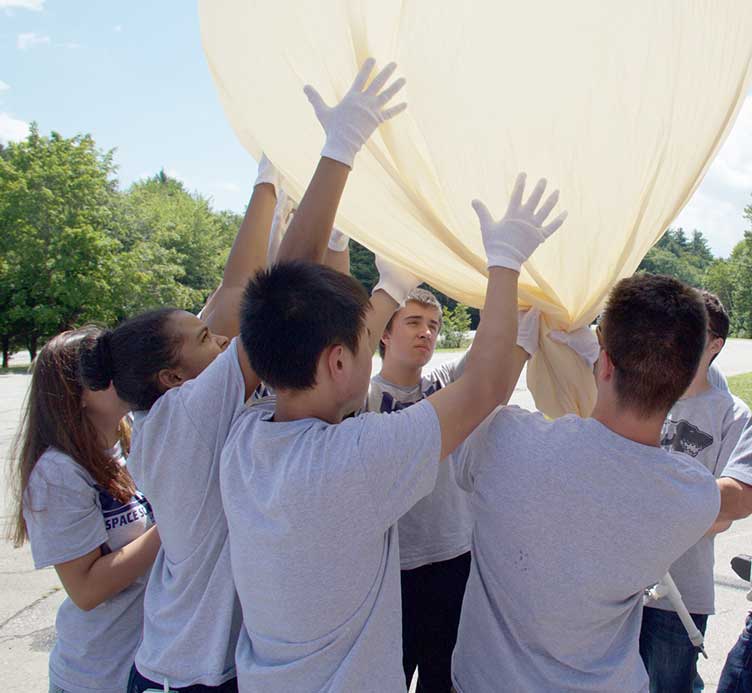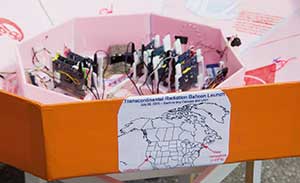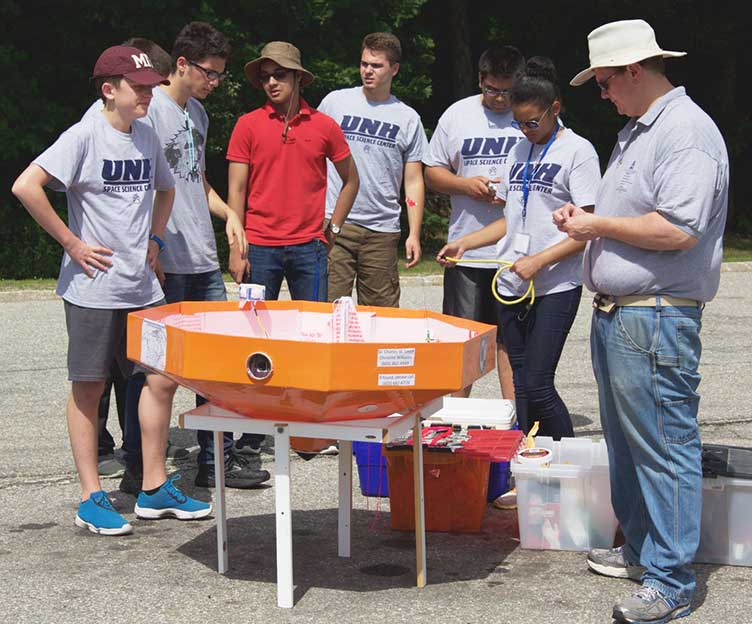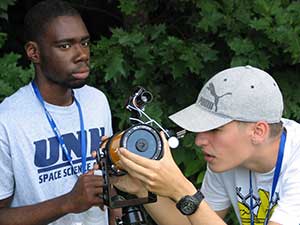
Near space is the swath of Earth’s atmosphere between 65,000 and 328,000 feet. It’s above where jets fly and below orbiting satellites and is composed of the stratosphere, mesosphere and lower thermosphere. On July 20, 17 high school students from six states and Europe gathered in Warner, New Hampshire, to send a scientific balloon into near space at 96,000 feet.
The teens are part of UNH’s Project SMART, Science and Mathematics Achievement through Research Training, which has been bringing high school juniors and seniors to campus for decades to get their hands dirty doing real science. The four-week program is designed to help spur teens’ interest in science and math careers. Students work with faculty and mentors in three disciplinary modules: space science, marine and environmental science and bio- and nanotechnology.
The balloon they launched was equipped with a prototype gamma-ray detector built at the UNH Space Science Center, or SSC, and instruments designed to capture in-flight atmospheric data that scientists will use to better characterize the intercontinental atmospheric radiation environment. Two of the students involved helped craft the circuitry and did some programming that controlled the in-flight operations of the prototype detector.

vehicle with label noting the cross-continent
radiation experiment. (Photo: Devin Thomas,
University of British Columbia)
“This is the kind of thing you do as a junior or senior college undergraduate project,” says Richard Levergood, a physics teacher from Londonderry High School and one of three high school physics teachers who serve as Project SMART mentors. Physics teachers Lou Broad of Timberlane Regional High School and Scott Goelzer of Coe-Brown Northwood Academy also serve as mentors, and SSC research professor Charles Smith heads up the effort.
But, Levergood notes, those college undergraduates would already have taken courses in electrical engineering and computer science and the like, “so these kids are sort of getting the last part first and really getting a jump start.”
Indeed, the two students who helped ready the gamma-ray detector for flight — Dakotah Stirnweiss of New Ipswich, New Hampshire, and Kent Cassidy of Newport, Rhode Island — were exposed to circuitry and soldering, electrical engineering and programming for the first time and plan to pursue aspects of all that in their future endeavors.
“This experience has been very empowering,” says Cassidy. “It’s got more electrical engineering elements than I expected, and I’ve started to really enjoy that.” Adds Stirnweiss, “This is the only program I’ve done where they let you do so much hands-on work. There’s less talking and more guiding you along. It’s astounding — I’ve learned so much more useful knowledge in three weeks here than in a traditional classroom setting.”
The flight also provided an opportunity for SSC research associate professor Peter Bloser to test the prototype gamma-ray detector in the cold, airless environment of near space. Bloser hopes to fly a similar detector on an upcoming “CubeSat” satellite mission. CubeSats are small, low-cost satellites that can be put into space much more quickly than typical satellite missions.
Says Bloser, “We wanted to prove that it works fine in a near vacuum since it wouldn’t be practical to put this prototype into a thermal vacuum chamber, which we will do with the actual instrument. But this provided a quick-and-dirty test, and I made it clear to the students that they are actually contributing to a space mission proposal.”

"Our summer institute has provided the opportunity for a diverse group of students to learn the interdisciplinary nature of the various scientific fields and how math and computers converge with scientific research,” says Subhash Minocha, director of Project SMART and UNH professor of plant biology and genetics. “They also study and discuss the applications and implications of scientific advancements to society."
This year’s Project SMART scientific balloon launch was special because it occurred simultaneously with the launch of two other high-altitude scientific balloons also bound for near space. At the moment the Project SMART group launched their balloon, student science enthusiasts in the group Earth to Sky Calculus at Bishop Union High School in Bishop, California, launched two balloons — one alongside the Project SMART group in Warner, and one from 2,947 miles away in their home state.

Desmond Maynard (left) of Jamaica Plain, Mass.,
and Dimitris Baliakas of Thessaloniki, Greece,
track the ascent of their high-altitude scientific
balloon launched moments before.
(Photo: David Sims, UNH-EOS)
The coordinated launches were part of the first cross-country experiment to measure atmospheric radiation levels, notes Tony Phillips, the author of spaceweather.com and mentor to the Earth to Sky group. “We have a lot of findings but all our work to date has been done over one location in California, so this is a first step for us to find out what it’s like to make measurements across continental scales,” says Phillips, adding, “Ultimately, we’d like to have a network of balloons all around North America so that when there’s a solar storm we would launch all of them to see how the atmosphere responds on continental scales to solar activity.”
Such measurements are valuable because solar storms don’t stop at the top of the atmosphere but reach down to aviation altitudes and below. Thus, when you’re flying on an airplane, even during periods of quiet solar activity you can absorb a fairly substantial dose of cosmic radiation.
“Our balloons sample radiation from the ground level to aviation altitudes and all the way to the upper stratosphere where people are going to be sending space planes for the purpose of space tourism,” Phillips says.
Astrophysicist Nathan Schwadron of the SSC and UNH department of physics says, “One of the big questions is what exactly are the radiation levels that people encounter in airline travel. These simple experiments will help us understand that.”
To come up with answers, Schwadron will take the radiation instruments flown on the balloons into a laboratory and make comparisons with other radiation-reading instruments under development. He says the work students conducted in the Project SMART balloon experiments is “real and really valuable science.”
Funding for this year’s Project SMART was provided by University of New Hampshire scholarships, the Liberty Mutual Foundation, the Summer Search Organization and various biotechnology companies via scholarships, financial aid and lab supplies and equipment.

















































